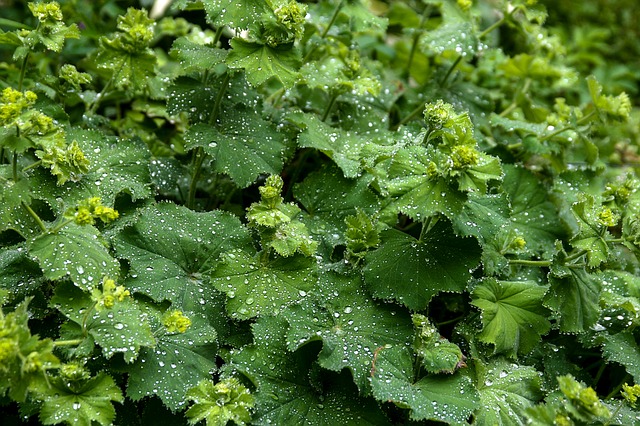 |  |  |  |  |
 |  |
Common lady's mantle (Alchemilla vulgaris) is a perennial herbaceous plant with one or several creeping stems that rise upward during the flowering period. It has a thick, horizontally positioned root system and grows up to 30 cm tall. The basal leaves are long-petioled and kidney-shaped with slightly wavy margins. The main stem leaves are semicircular with arched lobes, covered with fine hairs on both sides, and have toothed edges. Upper leaf blades are sessile and lack petioles.
A notable feature of lady's mantle is its ability to retain morning dew in the funnel-like base of each leaf. The plant also excretes droplets of liquid from specialized glands (hydathodes) at the leaf margins—a process known as guttation. Due to dense hair coverage, the leaves remain almost dry even after rainfall.
Lady's mantle can flower twice per year, typically beginning in June, with a second flowering often occurring in September. The flowers are small, greenish, and gathered in narrow, corymbose-panicle inflorescences resembling small spheres. The flower formula is *K(5)C1+2+(2)A9G1. By August, it produces dry fruits—achenes. Propagation occurs both vegetatively (via rhizome fragments) and by seed.
Harvesting of Raw Materials
Lady's mantle herb is collected from mid-May to July during the day, once the dew droplets on the plant have dried. The aerial parts—leaves, shoots, and flowers—are cut with a knife and dried in the shade in a well-ventilated area. Drying can also be done in special dryers at a temperature not exceeding 60 °C. The dried material is stored in paper packaging for no longer than one year, as it acquires an unpleasant bitter taste over time.
The roots of lady's mantle are also used for medicinal purposes. They are dug up in autumn (in September), thoroughly shaken free of soil, and then dried in an attic. The roots should be stored in cloth bags in a dry place for no more than two years.
Chemical Composition
The medicinal properties of Alchemilla vulgaris are due to its unique chemical composition. The plant contains tannins (up to 8% in the roots and up to 3% in the aerial parts), bitter compounds, lipids, catechins, lecithin, lignin, oleic, ellagic, luteolin, and linoleic acids, flavonoid glycosides, steroids, and coumarins. The leaves are especially rich in vitamin C (approximately 200 mg), as well as zinc, manganese, and boron.
Pharmacological Properties
Phytosterols (steroids) found in Alchemilla vulgaris have progesterone-like activity. They help regulate metabolic processes, support heart and vascular function, and strengthen the immune system.
Flavonoids in the plant demonstrate antiviral properties, particularly against influenza viruses. These bioflavonoids also act as strong antioxidants.
Lignin in the plant has detoxifying and antioxidant effects, promoting the elimination of toxins, salts, and heavy metals from the body.
Alchemilla vulgaris supports heart health and may help prevent heart attacks. Due to the presence of coumarins, plant-based preparations can accelerate wound healing.
The plant also exhibits antioxidant, regenerative, wound-healing, and capillary-strengthening properties.
Use in Traditional Medicine
Lady’s mantle (Alchemilla vulgaris) is widely used in traditional medicine due to its unique composition and beneficial properties. It is used as a diuretic, anti-inflammatory, expectorant, wound-healing, and astringent agent.
Water infusions and decoctions are taken orally for respiratory diseases, pneumonia, bronchitis, bronchial asthma, and tuberculosis as anti-inflammatory and expectorant remedies. It is also used for inflammation of the liver, gallbladder, and urinary bladder, spinal cord diseases, gout, rheumatic pain, and diabetes.
Decoctions help treat internal bleeding, especially uterine bleeding, gastric and duodenal ulcers, inflammation of the intestines and stomach, diarrhea, and insufficient intestinal peristalsis.
Leaf decoction in grape wine is used for heart pain relief, metabolism activation, dropsy, dyspepsia, anemia, and atherosclerosis.
Lady’s mantle infusion is used orally for hemorrhoids and locally as tampons.
In folk medicine, it is also used for weight loss by combining oral intake of herbal infusions with physical exercise, which promotes metabolism and blood circulation. Fabric soaked in lady’s mantle decoction is applied to problem areas affected by cellulite.
Lady’s mantle is truly a women’s herb; its decoctions used as douches are effective for menstrual disorders, painful menstruation, and menopause.
Externally, the decoction is used as lotions for acne, weeping eczema, conjunctivitis, and for gargling with stomatitis. Fresh leaves or decoction are applied externally for skin inflammations, boils, scrofula, purulent and slow-healing wounds, ulcers, and bruises.
The decoction is used for nasal rinses to clear mucus and stop nosebleeds.
Lady’s mantle infusion is used in baths for rickets and purulent diseases in children. Compresses made from leaves help with tumors and sprains.
